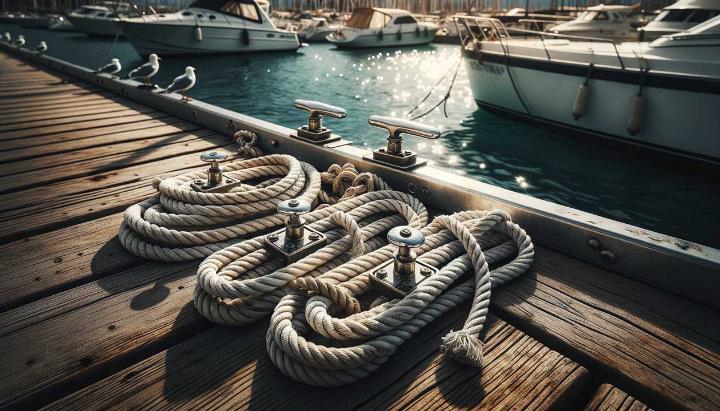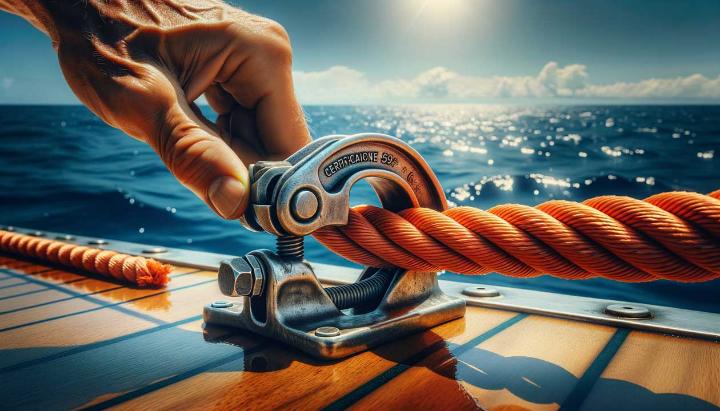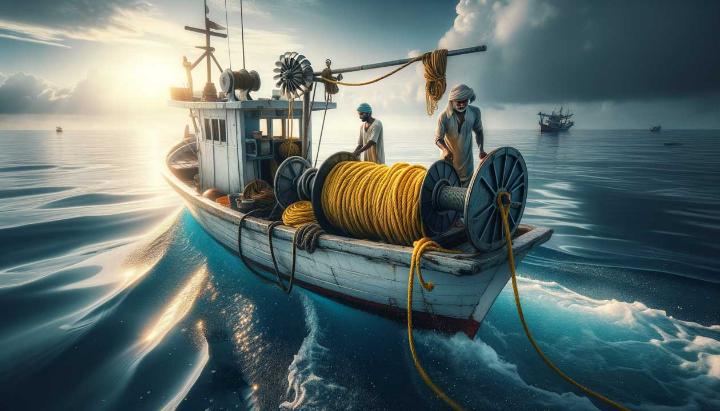Have you ever wondered why modern ships seem to glide effortlessly through the waves, their rigging light as a feather? The secret lies in a revolution that's been quietly transforming the maritime industry: fiber ropes. These lightweight marvels are not only changing the game for sailors and shipowners but are also making waves in the world of marine rope clamps and metal winch cables.
In this ultimate guide, we'll dive deep into the world of marine hardware, exploring how the right choice of metal rope clamps, metal winch cable, and marine rope clamps can make or break your nautical experience. From the decks of luxury yachts to the rugged environments of commercial fishing vessels, these unassuming components play a crucial role in safety, efficiency, and performance at sea.
Join us as we unravel the mysteries behind these essential marine tools, and discover how the latest innovations in fiber rope technology are reshaping the way we approach maritime operations. Whether you're a seasoned sailor or a curious enthusiast, this guide will equip you with the knowledge to make informed decisions about your marine hardware needs. Are you ready to set sail on this enlightening journey? Let's cast off!
Benefits of Fiber Ropes in Marine Environments
When it comes to marine applications, the choice of rope can make all the difference. As an avid sailor, I've experienced firsthand the advantages of fiber ropes over traditional materials. Let's dive into why these modern marvels are making waves in the maritime world.
Advantages of Synthetic Fiber Ropes vs Wire Ropes
Synthetic fiber ropes have revolutionised the marine industry, offering a host of benefits that traditional wire ropes simply can't match. Here's why they're becoming the go-to choice for many seafarers:
- Lightweight yet strong: Fiber ropes boast an impressive strength-to-weight ratio, making them easier to handle without compromising on load capacity.
- Corrosion-resistant: Unlike wire ropes, synthetic fibers don't rust or degrade in saltwater environments, ensuring longer-lasting performance.
- Flexible and easy to handle: The pliable nature of fiber ropes makes them much easier to coil, splice, and work with on deck.
- Safer for crew: With no risk of sharp wire strands, fiber ropes reduce the chance of injuries during handling.
Did You Know?
Modern synthetic fiber ropes can be up to 80% lighter than steel wire ropes of the same strength!
Applications of Fiber Ropes in Naval and Oceanographic Operations
The versatility of fiber ropes makes them ideal for a wide range of marine applications. From my experience working on research vessels, I've seen these ropes excel in various scenarios:
- Mooring lines: Their ability to absorb shock loads makes fiber ropes perfect for securing vessels to docks or buoys.
- Towing lines: The lightweight nature of fiber ropes reduces the risk of snapback during towing operations.
- Oceanographic research: When deploying sensitive equipment, the neutral buoyancy of certain fiber ropes prevents interference with data collection.
- Aquaculture: Resistant to marine growth and easy to clean, fiber ropes are ideal for fish farming operations.
Have you ever wondered why you see fewer wire ropes on modern vessels? It's because fiber ropes are not just a trend – they're a game-changer in maritime operations. Their combination of strength, durability, and ease of use makes them the smart choice for both small pleasure craft and large commercial ships.
As we continue to explore the world's oceans, the role of fiber ropes in marine environments will only grow. Whether you're rigging a sailboat or equipping a deep-sea research vessel, considering fiber ropes could significantly enhance your maritime experience. Have you made the switch to fiber ropes yet? If not, it might be time to rethink your rigging!
Selecting the Right Marine Rope Clamps for Your Application
As a seasoned sailor who's weathered countless nautical miles, I can't stress enough the importance of choosing the right marine rope clamps. These unassuming pieces of hardware play a crucial role in ensuring the safety and efficiency of your marine operations. Let's dive into the world of marine rope clamps and explore how to select the perfect ones for your needs.
Types of Marine Rope Clamps and Their Uses
When it comes to marine rope clamps, there's no one-size-fits-all solution. Different situations call for different types of clamps. Here are the main contenders you'll encounter:
- U-Bolt clips: These versatile clamps are perfect for quick, temporary connections. I've used them countless times for emergency repairs at sea.
- Double saddle clips: Also known as Fist Grip clips, these provide a more secure connection and are ideal for permanent installations.
- Stainless steel clips: These are the champions of saltwater environments, resisting corrosion like a champ.

Factors to Consider When Choosing Marine Rope Clamps
Selecting the right clamp isn't just about picking the shiniest one off the shelf. Here are some crucial factors to keep in mind:
- Rope material: Synthetic fiber ropes require different clamps than wire ropes. Always match the clamp to your rope type.
- Environment: Will your clamps be exposed to saltwater? Opt for corrosion-resistant materials like stainless steel.
- Load requirements: Consider the weight and force your clamps will need to withstand. Safety should always be your top priority.
- Clamp size: Ensure the clamp diameter matches your rope size. A mismatch could lead to slippage or damage.
Remember the golden rule of marine rope clamps: "Never saddle a dead horse." This means always placing the U-bolt on the dead (non-load bearing) end of the rope. It's a simple trick that can significantly enhance the security of your connection.
Always follow manufacturer guidelines for installation and maintenance of marine rope clamps. Improper use can lead to dangerous situations at sea.
Choosing the right marine rope clamps might seem like a small detail, but it's these little things that can make a big difference when you're out on the water. Have you had any experiences where the right (or wrong) clamp made all the difference? Share your stories in the comments below!
Ensuring Safe and Efficient Operation with Metal Rope Clamps
As a marine engineer with over a decade of experience, I've seen firsthand how crucial metal rope clamps are in ensuring the safety and efficiency of maritime operations. Let's dive into why these unassuming pieces of hardware are so important and how to make the most of them.
Advantages of Metal Rope Clamps
Metal rope clamps offer several benefits over other clamping methods:
- Superior strength and durability: Metal clamps can withstand extreme forces and harsh marine environments.
- Versatility: They're suitable for various rope types and sizes, from thin wire ropes to thick synthetic fibres.
- Easy installation and adjustment: With the right tools, metal clamps can be quickly installed or repositioned as needed.
- Cost-effective: Their longevity and reliability make them a smart investment for any marine operation.
Key Features to Look for in Marine Metal Rope Clamps
When selecting metal rope clamps for marine use, keep these crucial factors in mind:
- Corrosion resistance: Opt for stainless steel or galvanised clamps to withstand saltwater exposure.
- Proper sizing: Ensure the clamp matches your rope's diameter for optimal grip and performance.
- Load capacity: Choose clamps rated for the maximum expected load, with a suitable safety factor.
- Certification: Look for clamps that meet relevant industry standards and certifications.

Best Practices for Installing and Maintaining Metal Rope Clamps
To ensure the longevity and effectiveness of your metal rope clamps, follow these guidelines:
- Follow manufacturer instructions: Always adhere to the specific installation guidelines provided by the clamp manufacturer.
- Use the correct torque: Tighten clamps to the recommended torque specifications to avoid over or under-tightening.
- Proper spacing: Maintain the correct distance between clamps as specified in the OSHA guidelines.
- Regular inspections: Conduct routine checks for signs of wear, corrosion, or loosening.
- Retorque after initial loading: Check and retighten clamps after the first load application, as ropes may settle.
Remember: The efficiency of a properly installed metal rope clamp can reach up to 80% of the rope's breaking strength. Always prioritise safety and follow OSHA guidelines for wire rope usage and maintenance.
By following these best practices and choosing the right metal rope clamps for your marine applications, you'll ensure safer, more efficient operations on the water. Have you encountered any challenges with metal rope clamps in your maritime experiences? Share your stories in the comments below – your insights could help fellow seafarers navigate these crucial safety measures!
Enhancing Performance with High-Quality Metal Winch Cables
As a seasoned marine engineer, I've seen firsthand how crucial high-quality metal winch cables are in maritime operations. Whether you're hauling heavy loads or performing complex manoeuvres at sea, the right winch cable can make all the difference. Let's dive into the world of metal winch cables and explore how they can enhance your marine operations.
Benefits of Steel vs Synthetic Winch Cables
While synthetic ropes have gained popularity in recent years, steel winch cables still hold their ground in many marine applications. Here's why:
- Superior strength-to-weight ratio: Steel cables can handle immense loads without stretching or breaking, crucial for heavy-duty marine operations.
- Heat resistance: Unlike synthetic ropes, steel cables won't melt or weaken under high temperatures, making them ideal for extended winching operations.
- Durability: Steel cables can withstand abrasion and harsh marine environments, often outlasting their synthetic counterparts in demanding conditions.
- Cost-effective: While initially more expensive, the longevity of steel cables often results in better value over time.
That said, synthetic winch lines have their place too. They're lightweight, easier to handle, and don't store energy like steel cables, reducing the risk of snapback. The choice between steel and synthetic often comes down to your specific needs and operating conditions.

Choosing the Right Winch Cable for Your Needs
Selecting the perfect metal winch cable isn't just about picking the strongest option. Consider these factors:
- Breaking strength: This is the maximum load a cable can handle before failing. Always choose a cable with a breaking strength well above your maximum expected load.
- Winch capacity: Ensure your cable's strength matches or exceeds your winch's rated capacity.
- Environmental conditions: If you're operating in saltwater, opt for galvanised or stainless steel cables to resist corrosion.
- Cable diameter and length: These should be compatible with your winch drum and suit your typical operating distances.
Remember, a winch is only as strong as its weakest component. Investing in a high-quality metal winch cable ensures you're getting the full performance out of your equipment.
Properly caring for your metal winch cable is crucial for its longevity and performance. After each use, clean the cable with fresh water to remove salt and debris. Apply a light coat of marine-grade lubricant to prevent rust and reduce friction. And always store your winch with the cable fully retracted to protect it from the elements.
Have you had any experiences with metal winch cables in challenging marine conditions? Share your stories in the comments below – your insights could help fellow mariners make informed decisions about their winching equipment!
Choosing the right marine rope clamps and metal winch cables is vital for marine applications. Synthetic fiber ropes are popular due to their lightweight, buoyant properties and versatility. Understanding and selecting the appropriate marine rope clamps, such as U-Bolt, double saddle, and stainless steel clips, ensures safety and durability. Metal rope clamps offer superior strength and flexibility, making them ideal for various marine uses. High-quality metal winch cables provide necessary load capacity and resilience in harsh conditions. Whether for anchoring, towing, or research, the right equipment enhances performance and safety at sea.
Get Expert Advice on Your Marine Rope and Winch Needs
If you have any questions or need further assistance, please fill out the inquiry form above. Our team is ready to help you find the best solutions for your marine rope and winch requirements.